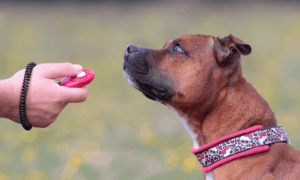Training a dog with a shock collar is a controversial method. Still, it can be an effective tool when used responsibly and under the guidance of a professional trainer or experienced dog owner. It uses electric impulses delivered to the dog’s neck to respond to specific commands or behaviors. This article will provide a comprehensive overview of how to train a dog with a shock collar, including the benefits and drawbacks, ethical considerations, and best practices for utilizing this tool.
Shock collars are a tool that can use to train dogs and correct specific behavior issues. However, understand that using a shock collar should be considered a last resort after other training methods have been attempted and found ineffective.
Additionally, it’s crucial to consult with a professional trainer or behaviorist before using a shock collar to ensure that it is the right choice for your dog and that you are adequately trained in its use.
When training a dog with a shock collar, it is essential to use positive reinforcement techniques in conjunction with the collar. This means rewarding your dog with treats or praise for good behavior rather than only using the collar to correct bad behavior. Positive reinforcement helps to build trust and communication between you and your dog, which is essential for practical training.
Moreover, it’s crucial to start with the lowest level of stimulation possible and gradually increase it only if necessary. It’s essential to be consistent and patient, have clear boundaries and limits, and not use the collar when angry or emotional.
It’s also vital to be aware of your dog’s physical and emotional reactions while using a shock collar, monitor their reactions, and adjust the training accordingly. If you notice that your dog is experiencing severe distress or fear, you must stop the training and reassess the situation, consult a professional, or seek an alternative training method.
How to train a dog with a shock collar

When training a dog with a shock collar, it’s vital first to understand that this method should only be used by experienced trainers or under the guidance of a professional dog trainer. Shock collars deliver a small electric shock to the dog‘s neck in response to a specific command or behavior.
It’s important to note that this training method should not be used as the sole method of training but rather as an aid in addition to other positive reinforcement techniques.
When using a shock collar, it’s essential to start with the lowest stimulation level and gradually increase it as needed. It’s also vital to never use the collar in an angry or punitive manner and to always pair it with positive reinforcement.
It’s also crucial to have a clear and consistent set of commands and always reward your dog for good behavior, primarily when it responds the way you want without needing the collar.
It’s important to remember that every dog is different and what works for one dog may not work for another. If you need clarification on using a shock collar or think this method may not be the best fit for your dog, it’s best to consult a professional dog trainer for guidance.
Also, it’s important to remember that these collars are inappropriate for all dogs. Some dogs may be too sensitive or aggressive and can respond negatively to this training or even get harmed by it.
Is it practical to use a shock collar to train a dog?
The use of shock collars for dog training is a controversial topic. They can be practical tools for correcting specific behavior issues. In contrast, others maintain that they are cruel and can cause harm to dogs both physically and emotionally.
Always note that using a shock collar should be considered a last resort after other training methods have been attempted and found to be ineffective. Additionally, the training process should always be done with positive reinforcement and a focus on building trust and communication with the dog.
Positive reinforcement techniques such as rewarding good behavior with treats and praise and gradually increasing the stimulation level only if necessary can make the dog understand the correct behavior.
However, suppose the training process needs to be done correctly, and the collar is used excessively or inappropriately. In that case, it can cause adverse effects such as fear, anxiety, and distress to the dog, leading to more significant behavior issues.
Therefore, it is crucial to consult with a professional trainer or behaviorist before using a shock collar and to ensure that you are adequately trained.
How do I properly use a shock collar for dog training?

Properly using a shock collar for dog training involves several key steps. First, it’s essential to start with the lowest stimulation level and gradually increase it as needed. This will allow the dog to become accustomed to the sensation and reduce the risk of adverse reactions such as fear or aggression.
Second, it’s essential never to use the collar in an angry or punitive manner and to always pair the use of the collar with positive reinforcement. So every time the dog responds to a command or exhibits good behavior, reward it with treats or vocal praise.
Third, it’s crucial to have a clear and consistent set of commands and use the collar only for specific behaviors you want to discourage.
Fourth, it’s essential to regularly check the collar’s fit and adjust it as needed to ensure the dog is comfortable and positioned correctly and securely on its neck.
Fifth, it’s essential to monitor your dog’s behavior when using the collar and stop the use of the collar if you notice any signs of distress or harmful behavior. It’s also important to be aware of the laws regarding the use of shock collars in your area and comply with any regulations.
Again, it’s important to emphasize that a shock collar should be used as an aid in addition to other positive reinforcement techniques and should never be the sole training method.
What are the risks and dangers of using a shock collar on a dog?
Using a shock collar on a dog can present several risks and dangers. One of the main risks is causing physical harm to the dog. A shock collar can deliver an electric shock that is too strong or is given for too long, which can lead to burns, injuries, or other physical harm.
Moreover, if the collar is not correctly fitted or is positioned incorrectly, it can cause choking, suffocation, or injury to the trachea or spinal cord.
Another risk associated with using a shock collar is causing psychological harm to the dog. The use of a shock collar can lead to the development of fear, anxiety, or aggression in dogs. This can manifest in various ways, such as cowering, hiding, biting, or even running away.
Additionally, if the collar is used too frequently or in an unpredictable manner, it can decrease the dog‘s trust and confidence in the trainer.
It’s also important to note that using a shock collar can interfere with the bond between the dog and its owner. Dogs rely on their sense of smell and touch to communicate with each other and with their human family. Using a shock collar can change how the dog perceives the relationship and make the dog feel insecure and unwilling to bond with their owner.
Another risk is that some jurisdictions have laws or regulations that restrict or prohibit the use of shock collars and using a shock collar can result in legal penalties or fines. Furthermore, it’s important to remember that in some cases, the use of a shock collar may not be an appropriate form of training for all dogs, especially in certain breeds or ages of dogs and dogs with certain medical conditions.
Is a shock collar humane for dog training?

The use of shock collars for dog training is considered by many to be inhumane due to the potential negative impact it can have on the dog’s physical and emotional well-being. Shock collars deliver an electric shock to the dog as a form of punishment for certain behaviors, which can cause fear, anxiety, and distress in the animal.
These adverse reactions can lead to further behavioral issues and mistrust in the owner. Additionally, there is no scientific evidence that using a shock collar is more effective than other positive reinforcement training methods, such as using rewards and praise for good behavior.
Furthermore, using physical punishment or force to train a dog can harm the relationship between the dog and the owner. In conclusion, the use of shock collars for dog training is considered by many to be inhumane, and it is not the recommended method of training by professional trainers and behaviorists.
Are there alternatives to using a shock collar for dog training?
Several alternatives to using a shock collar for dog training include positive reinforcement training, clicker training, and using a headcollar or a front-clip harness. Positive reinforcement training involves rewarding dogs for good behavior, while clicker training uses a small device that clicks to mark the desired behavior.
It can also use a headcollar or a front-clip harness to help control a dog‘s behavior without causing pain or discomfort. These methods are based on reward and positive association, which is considered more humane and effective in the long run.
It’s also important to consider that using a shock collar may harm the dog’s and the owner’s bond. It is always recommended to consult a professional dog trainer to find the best method for you and your furry friend.
How do I choose the right intensity level for a shock collar?

Choosing the right intensity level for a shock collar requires finding a balance between practical training and avoiding causing unnecessary pain or distress to the dog. It is recommended to start with the lowest level and gradually increase it if necessary while always observing the dog’s reaction.
If the dog responds well to the lowest level and shows no signs of discomfort or distress, it is probably unnecessary to increase the intensity.
However, if the dog does not respond to the lowest level, the intensity can be increased incrementally until the dog responds. It would help if you observed your dog’s reaction and sensitivity at each level of intensity. If the dog shows signs of distress at any point, such as yelping, whimpering, or trying to escape the collar, the power should be decreased immediately.
Can a shock collar cause harm or injury to a dog?
A shock collar can cause harm or injury to a dog if not used properly. A shock collar can cause physical pain and discomfort to a dog, as well as emotional distress and fear. Misuse of a shock collar, such as high intensity or leaving the collar on for an extended time, can cause burns, blisters, or other injuries on a dog’s skin.
Additionally, using a shock collar as a punishment can lead to behavioral problems, such as increased aggression or fearfulness. It’s also important to consider that using a shock collar can harm the relationship between the dog and the owner.
There are a lot of professional organizations that prohibit the use of electric collars, and many certified trainers will not use them. If you decide to use one, it’s always recommended to use it under the supervision of a professional trainer and to follow manufacturer guidelines and recommended use.
How do I teach my dog commands with a shock collar?

Teaching your dog commands with a shock collar involves using the collar to deliver electric stimulation as a punishment for not following an order or as a way to get their attention. It’s important to remember that punishment-based training methods can negatively affect the relationship between the dog and the owner and the mental state of the dog.
So it’s recommended to avoid using the collar to deliver punishment as a primary method. Instead, the Positive reinforcement-based training method should be used as a primary method where you reward good behavior, and the collar should be used only as an attention-getting device to capture the dog’s attention when distracted.
Training should always begin with the lowest intensity level and be used only when necessary. It’s also recommended to use a professional dog trainer to help you in this process and supervise the collar use.
How long should I use a shock collar for dog training?
A shock collar for dog training should be as brief as possible and only be used as a tool to support a more comprehensive training program. Should use shock collar only for as long as needed to achieve the desired behavior, after which the collar should be phased out of the training process.
Dog training aims to help the dog understand what is expected of them and build a positive relationship with the owner. Using a shock collar for a prolonged period may hurt the dog’s behavior, emotional state, and relationship with the owner.
Furthermore, it’s also important to consider that every dog is different, and some may require more or less time to learn. A professional dog trainer should help you to evaluate the training progress and determine when it’s appropriate to stop using the collar and rely more on positive reinforcement-based training methods.
Can a shock collar be used on small dogs or puppies?

Using a shock collar on small dogs or puppies is generally not recommended. Small dogs and puppies are more sensitive and can be easily harmed by the electric shock delivered by a shock collar.
Additionally, small dogs and puppies may have less developed nervous systems, making them more prone to experiencing adverse effects from the collar, such as fear, anxiety, and aggression. Furthermore, Using a shock collar on a puppy can interfere with the natural learning process and inhibit their ability to learn in the future.
As puppies are in a critical stage of development, any training must use positive reinforcement methods that encourage good behavior while not discouraging or traumatizing them.
How do I know if a shock collar is necessary for training my dog?
Determining if a shock collar is necessary for training your dog will depend on various factors, including your dog’s specific needs and behavior and your own experience and training goals. In general, it’s necessary to consider the following factors when evaluating whether or not a shock collar is essential for your dog:
The severity of the behavior you want to address: If your dog is exhibiting dangerous or aggressive behaviors, a shock collar may be necessary to help manage those behaviors. However, a may not require a shock collar if the behaviors are minor or easily corrected with other positive reinforcement techniques.
Your experience and comfort level with training: If you’re new to dog training or feel uncomfortable using a shock collar. Avoid using one and seek other positive reinforcement techniques with which you feel more comfortable.
Your dog’s temperament and sensitivity: Some dogs are more sensitive and may react negatively to using a shock collar, while others may not be affected at all. It’s essential to consider your dog‘s temperament when deciding whether or not to use a shock collar.
The availability of other positive reinforcement techniques and qualified trainers: If other positive reinforcement techniques and trainers can help you train your dog without using a shock collar, it may be best to use those instead.
It’s worth noting that a professional dog trainer can help you evaluate your dog‘s specific needs and recommend the best training methods for your situation. This can be very helpful in determining if a shock collar is necessary and how to use it properly, safely, and humanely.
Conclusion
In conclusion of how to train a dog with a shock collar, training a dog with a shock collar can be an effective tool when used responsibly and under the guidance of a professional trainer or experienced dog owner. It’s important to understand that this method should never be used as the sole training method and should always be used in conjunction with positive reinforcement techniques.
It’s also crucial to always start with the lowest level of stimulation, to never use the collar in an angry or punitive manner, and to have a clear and consistent set of commands. It’s also important to regularly check the collar’s fit, monitor the dog‘s behavior, and stop using the collar if any signs of distress or negative behavior are observed.
Additionally, it’s essential to consider the laws regarding the use of shock collars in your area and comply with any regulations. When done correctly, a shock collar can help train a well-behaved, obedient, and happy companion.


